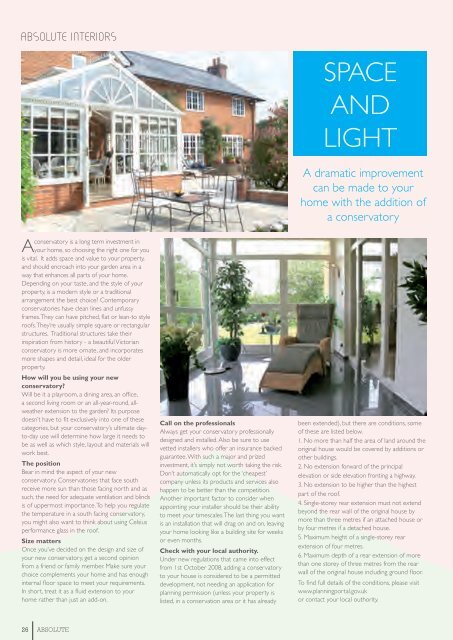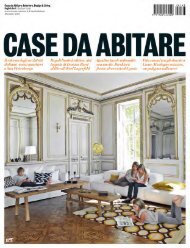You also want an ePaper? Increase the reach of your titles
YUMPU automatically turns print PDFs into web optimized ePapers that Google loves.
ABSOLUTE INTERIORS<br />
conservatory is a long term investment in<br />
A your home, so choosing the right one for you<br />
is vital. It adds space and value to your property,<br />
and should encroach into your garden area in a<br />
way that enhances all parts of your home.<br />
Depending on your taste, and the style of your<br />
property, is a modern style or a traditional<br />
arrangement the best choice? Contemporary<br />
conservatories have clean lines and unfussy<br />
frames. They can have pitched, fl at or lean-to style<br />
roofs. They’re usually simple square or rectangular<br />
structures. Traditional structures take their<br />
inspiration from history - a beautiful Victorian<br />
conservatory is more ornate, and incorporates<br />
more shapes and detail, ideal for the older<br />
property.<br />
How will you be using your new<br />
conservatory?<br />
Will be it a playroom, a dining area, an offi ce,<br />
a second living room or an all-year-round, allweather<br />
extension to the garden? Its purpose<br />
doesn’t have to fi t exclusively into one of these<br />
categories, but your conservatory’s ultimate dayto-day<br />
use will determine how large it needs to<br />
be as well as which style, layout and materials will<br />
work best.<br />
The position<br />
Bear in mind the aspect of your new<br />
conservatory. Conservatories that face south<br />
receive more sun than those facing north and as<br />
such, the need for adequate ventilation and blinds<br />
is of uppermost importance. To help you regulate<br />
the temperature in a south facing conservatory,<br />
you might also want to think about using Celsius<br />
performance glass in the roof.<br />
Size matters<br />
Once you’ve decided on the design and size of<br />
your new conservatory, get a second opinion<br />
from a friend or family member. Make sure your<br />
choice complements your home and has enough<br />
internal fl oor space to meet your requirements.<br />
In short, treat it as a fl uid extension to your<br />
home rather than just an add-on.<br />
26 ABSOLUTE<br />
Call on the professionals<br />
Always get your conservatory professionally<br />
designed and installed. Also be sure to use<br />
vetted installers who offer an insurance backed<br />
guarantee. With such a major and prized<br />
investment, it’s simply not worth taking the risk.<br />
Don’t automatically opt for the ‘cheapest’<br />
company unless its products and services also<br />
happen to be better than the competition.<br />
Another important factor to consider when<br />
appointing your installer should be their ability<br />
to meet your timescales. The last thing you want<br />
is an installation that will drag on and on, leaving<br />
your home looking like a building site for weeks<br />
or even months.<br />
Check with your local authority.<br />
Under new regulations that came into effect<br />
from 1st October 2008, adding a conservatory<br />
to your house is considered to be a permitted<br />
development, not needing an application for<br />
planning permission (unless your property is<br />
listed, in a conservation area or it has already<br />
SPACE<br />
AND<br />
LIGHT<br />
A dramatic improvement<br />
can be made to your<br />
home with the addition of<br />
a conservatory<br />
been extended), but there are conditions, some<br />
of these are listed below.<br />
1. No more than half the area of land around the<br />
original house would be covered by additions or<br />
other buildings.<br />
2. No extension forward of the principal<br />
elevation or side elevation fronting a highway.<br />
3. No extension to be higher than the highest<br />
part of the roof.<br />
4. Single-storey rear extension must not extend<br />
beyond the rear wall of the original house by<br />
more than three metres if an attached house or<br />
by four metres if a detached house.<br />
5. Maximum height of a single-storey rear<br />
extension of four metres.<br />
6. Maximum depth of a rear extension of more<br />
than one storey of three metres from the rear<br />
wall of the original house including ground fl oor.<br />
To fi nd full details of the conditions, please visit<br />
www.planningportal.gov.uk<br />
or contact your local outhority.

















